 VIEUX ARTICLES SUR LES CHIENS DU TIBET
VIEUX ARTICLES SUR LES CHIENS DU TIBET LE CHASSEUR FRANCAIS 1941
LE CHASSEUR FRANCAIS 1941
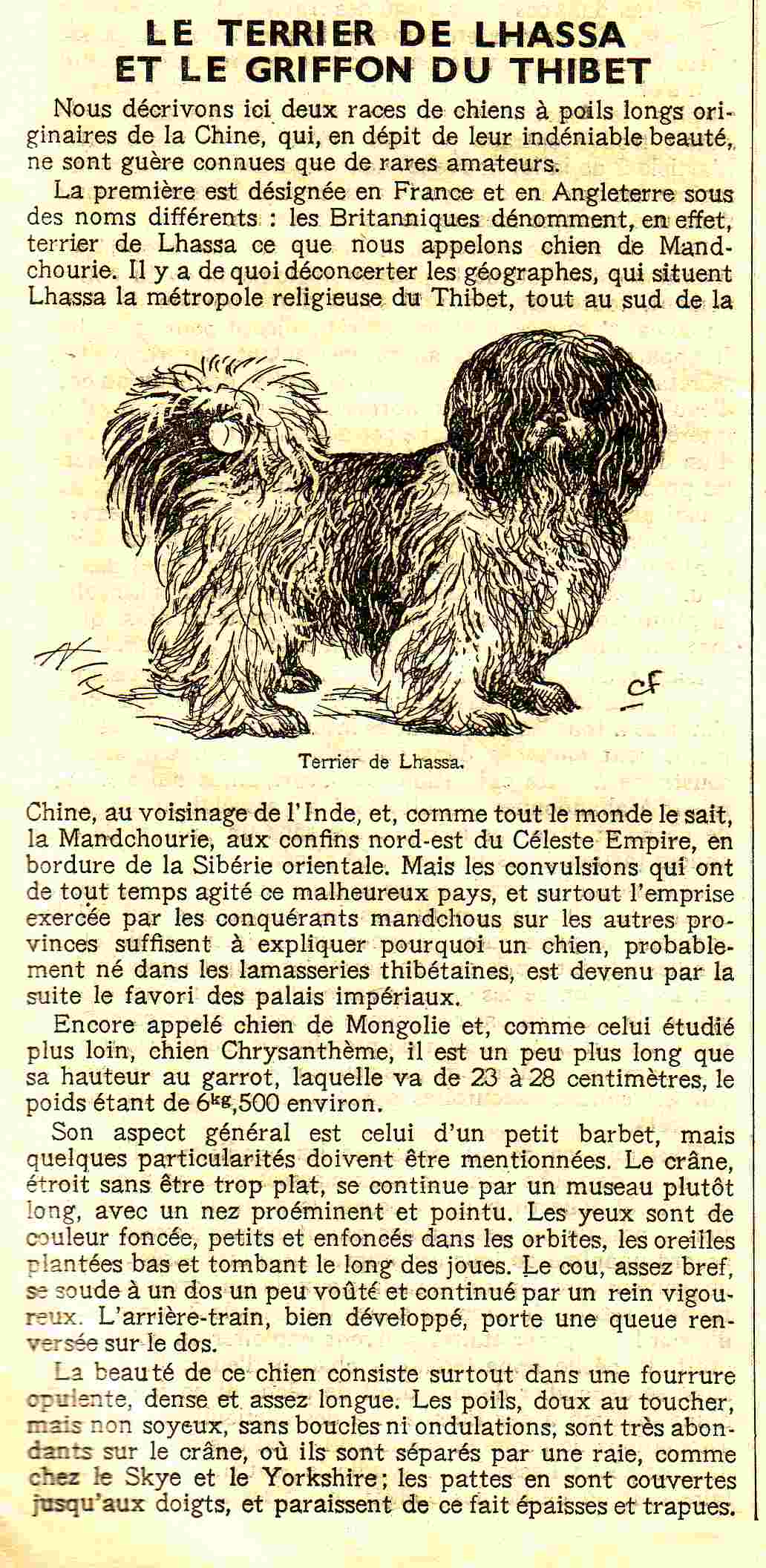
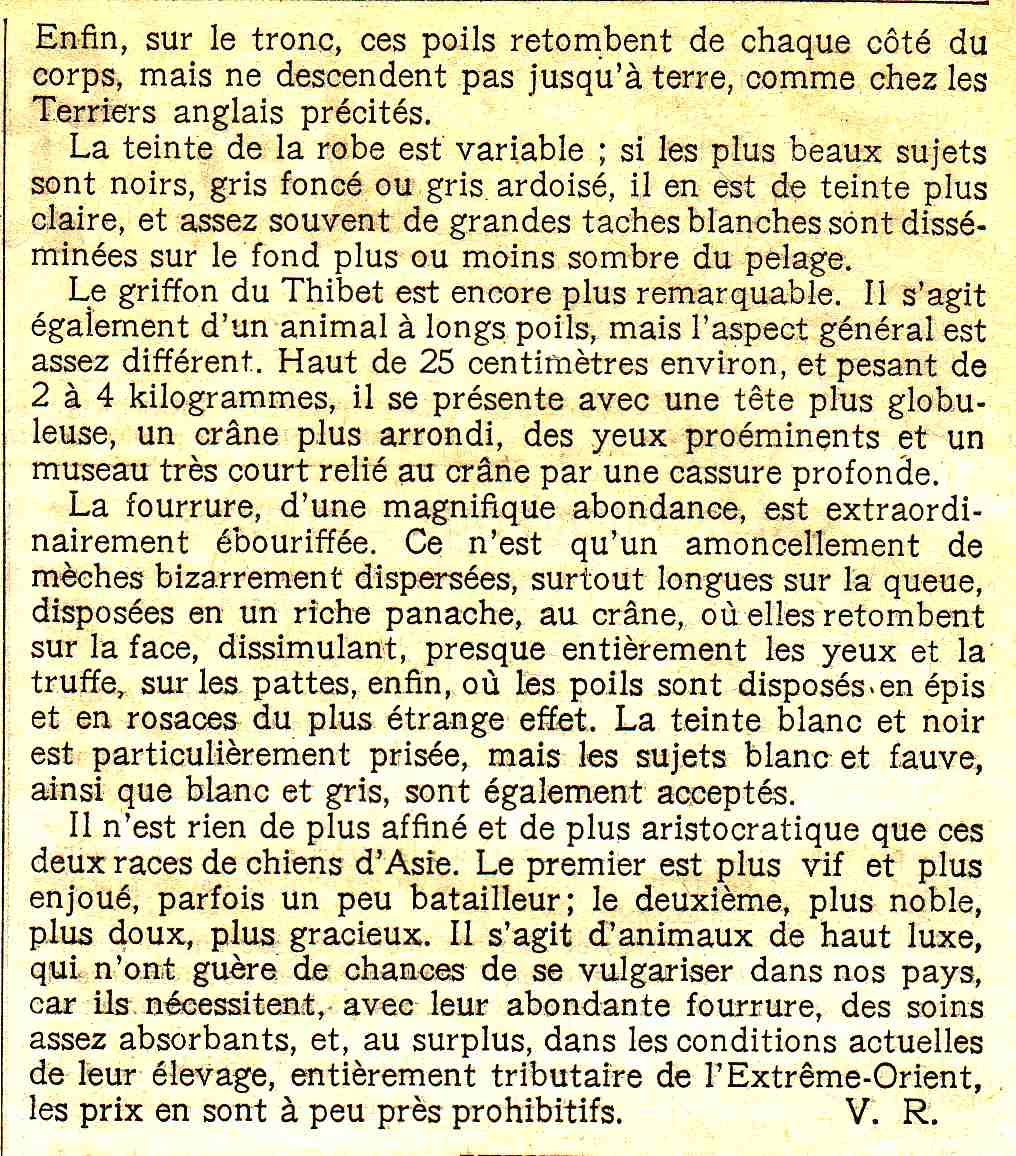 Merci à Susan Waller Miccio
Merci à Susan Waller Miccio
pour son travail de traduction des articlesSi vous voulez visiter son site
v

The Lhassa Terrier and the Griffon of Tibet
This article appeared in Le Chasseur Français (The French Hunter) in 1941, in the midst
of World War II.
We describe here two long-haired dog breeds
that originated in China,
who, despite their undeniable beauty, are little known except to a few
enthusiasts.
The first is known by different names in France
and England: what the British call the breed the Lhassa
Terrier we [French] call the Dog of Manchuria.
This name is disconcerting to geographers, as Lhasa, the religious
center of Tibet, is situated all the way in the south of China, in the vicinity
of India, while, as everyone knows, Manchuria, is in the northeast of the Celestial
Empire, bordering on eastern Siberia. The upheavals that always agitate this
unfortunate country and especially the influence exerted from the Manch conquerors
on the other provinces suffice to explain why a dog, probably born in the
Tibetan lamaseries, later became the favorite in the imperial palaces.
Also called the
Dog of Mongolia and, like the one studied longer, Chrysanthemum Dog, he is a
little longer than his height at the withers, from 23 to 28 centimeters [9-11
inches], the weight being about 6 kg 500 [14 lbs., 5 oz.] His general appearance is that of a small
spaniel, although certain specifics deserve mention. The skull, narrow without
being too flat, features a rather long muzzle, with a prominent and sharp
nose. The eyes are dark-colored, small
and deep-set, the ears set low and falling down the cheeks. The fairly short neck is joined to a slightly
arched back that continues to a sturdy loin. The well-developed hindquarters
carry a tail arched over the back.
The beauty of
this dog consists especially in an opulent coat, which
is dense and quite
long. The hair, soft to the touch, but not
silky, is free from curl or wave
and is very abundant on the head, where it is separated by a line, as in the Skye and
Yorkshire. The legs are covered with
hair to the toes and therefore appear thick and chunky. Finally, on the trunk, this hair falls on
each side of the body, but does not fall all the way to the ground as it does
in the English terriers mentioned above.
The color of
the coat varies. Though the most
beautiful subjects are black, dark gray or slate gray, others are lighter in
color, often with large white patches under a more-or-less dark coat.
The Griffon of
Tibet is even more remarkable. It is also a
long-haired dog, but the general appearance is
quite different. About 25 centimeters [9 ⅞ inches] high,
and weighing 2 to 4 kilograms (4.5 – 8 lbs.), he has a more globular head, with
a more rounded skull, prominent eyes and a very short muzzle, a deep stop where
it connects to the skull.
The coat of magnificent abundance is extraordinarily ruffled. It's just a mound
of bizarrely dispersed strands,
especially long on the plumed tail, on the head – where they
fall over the face, almost entirely hiding the eyes and
nose – and finally on the legs where the hair forms curious-looking
spikes and rosettes. The white and black
color is particularly prized, but the individuals that are white and tan, as
well as white and gray, are equally acceptable.
Nothing is more refined and aristocratic than these two Asian dog
breeds. The first is more lively and playful, sometimes a
little pugnacious; the second is nobler, sweeter, more graceful.
These are animals of high luxury, which are hardly
likely to be popularized in our country, as they
require, with their abundant
coats, rather extensive
care. Moreover, given that their breeding currently depends
entirely on the Far East, the prices are nearly
prohibitive.
 LE CHASSEUR FRANCAIS 1957
LE CHASSEUR FRANCAIS 1957
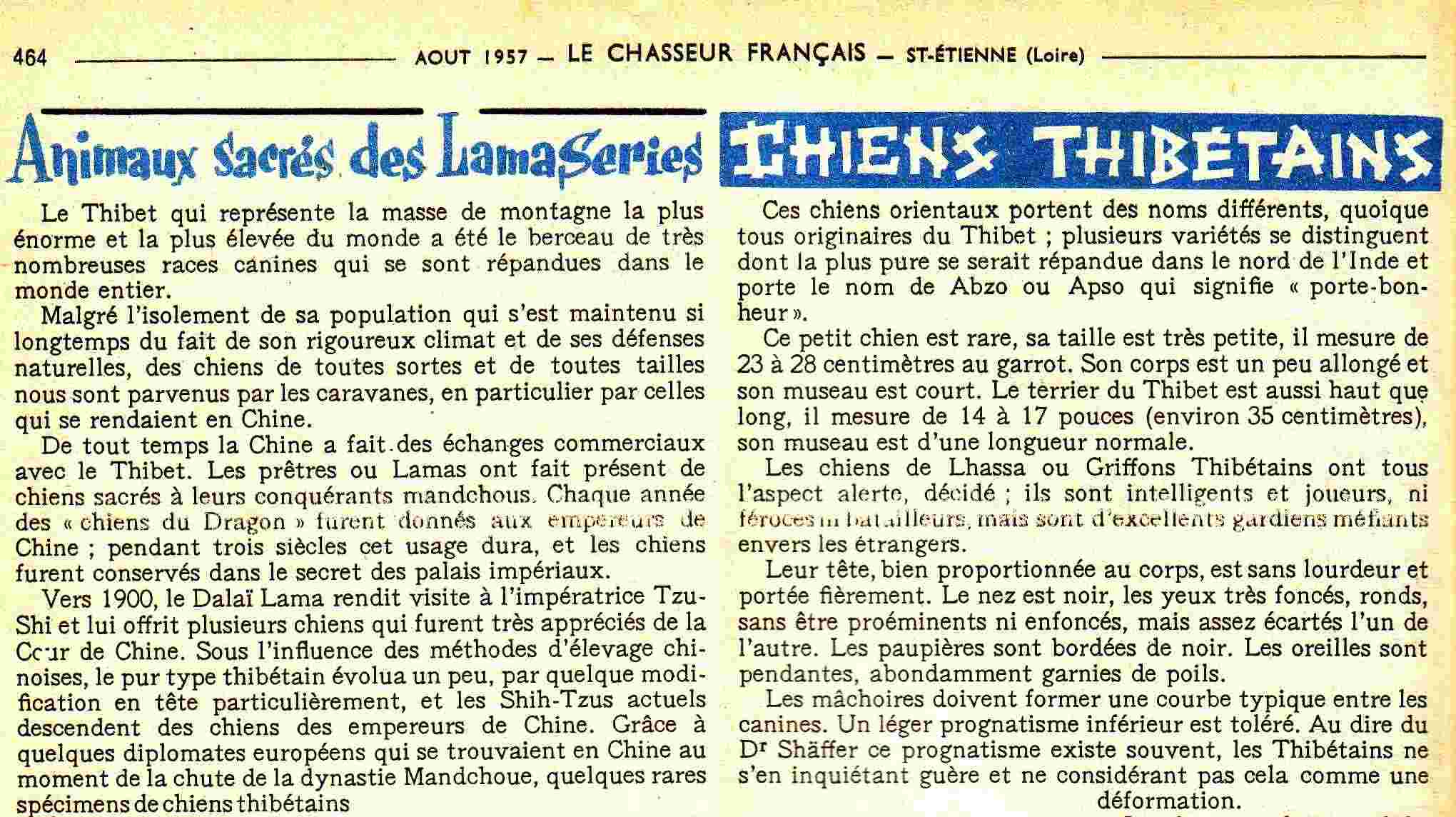
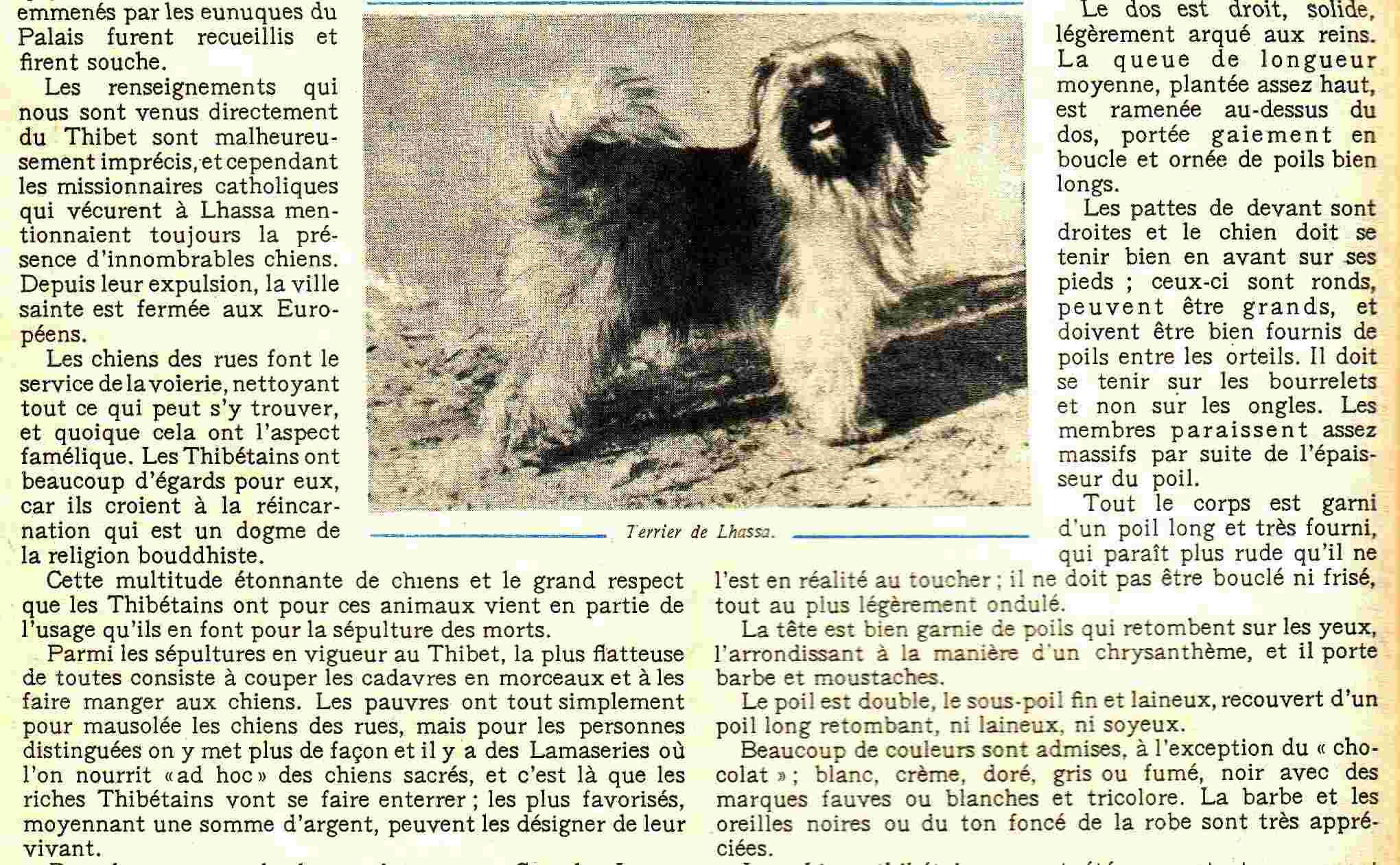

t
Merci à Susan Waller Miccio
pour son travail de traduction des articles
Si vous voulez visiter son site
v

Sacred Animals of the Lamaseries
This article appeared in Le Chasseur Français (The French Hunter) in August, 1957.
Tibet, where
the most enormous and tallest mountains in the world are located, was the
cradle of many dog breeds that have spread around the world.
Despite the historic isolation of its
population due to the rigorous climate and natural barriers, dogs of all sorts
and all sizes were brought to us by caravans, especially by those that went to China.
China has always traded with Tibet. The priests, or Lamas, presented some sacred
dogs to their Manchu conquerors. Each
year, some “Dragon dogs” were given tothe emperors of China. This practice continued for three centuries,
and the dogs were kept in the secrecy of the imperial palaces.
Around 1900, the Dalai Lama paid a visit to
the Empress Tzu-Shi and offered her several dogs that were very appreciated in
the Chinese court. Under the influence
of Chinese breeding methods, the pure Tibetan type evolved a little,
particularly by some modification of the head, and current day Shih-Tzus
descend from these dogs of the Chinese emperors. Thanks to some European diplomats, who found
themselves in China when the Manchu dynasty fell, some rare specimens of Tibetan
dogs lead by the eunuchs of the palace were collected and became the origin [of
the breed].
The information that has come to us
directly from Tibet has
unfortunately been imprecise although the Catholic missionaries who lived in Lhasa always mentioned
the presence of innumerable dogs. Since
their expulsion, the sacred city has been closed to Europeans.
The street dogs do the work of
street-cleaners, cleaning up everything that they find there, even though they always
have a hungry look. The Tibetans have
much respect for them because they believe in reincarnation, which is a tenet of
the Buddhist religion.
This astonishing multitude of dogs and the
great respect that the Tibetans have for these animals comes in part from the
service they peform in the burial of the dead. Of the burial customs in Tibet, the most
honorable of all consists of cutting the corpses into pieces and letting dogs
eat them. For their mausoleum, the poor
have simply the street dogs. But, for
distinguished people, there are more options.
There are lamaseries [monasteries] where the sacred dogs are fed an informal
manner, and this is where the rich go to be buried. The most favored, for a sum of money, can
designate this burial during their lifetime.
Many sacred dogs are bred In the monasteries of the high plateaus – or grand lamaseries.
The lamas would “serve their purgatory" in these venerated dogs, which were specially trained for religious
ceremonies and which also guard the
treasures of Buddha in the
temple. In these monasteries,
great freedom is given
to them and small and large dogs were allowed to cross-breed according
to their preferences. They were
little known in Europe,
because the males could be given as a good luck charm to
explorers passing through but the carefully guarded females were rarely allowed to leave.
In 1939, an important mission visited Tibet, and Dr.
Shaffer, the German head of the mission, brought back valuable
information. There was an Austrian
standard for the dog of Lhasa. There was also an English standard for the
Tibetan terrier. These oriental dogs
carried different names although all originated in Tibet. Several
varieties are seen, of which the purest was widespread
in northern India
and was called Abzo or Apso, which means good luck charm.
This little dog is rare, its size very small. He measures from 23 to 28 centimeters [9-11
inches] at the withers. His body is a little elongated and his muzzle is
short. The terrier of Tibet is as
high as long, measuring from 14 to 17 inches, (about 35 centimeters) and his
muzzle is of a normal length. The ‘dogs of Lhasa’ or Tibetan Griffons all have an alert,
determined expression. They are
intelligent and playful, neither ferocious nor fighters, but they are excellent
guard dogs and distrustful toward strangers.
Their head, well-proportioned to the body, is without heaviness and is
carried proudly. The nose is black, the
very dark eyes are round without being too prominent or deep-set, but set well apart
from one another. The eyelids are
bordered in black. The drop-ears are
well-furnished with hair. The bite must
form a typical curve between the canines.
A slight underbite is acceptable.
According to Dr. Shaffer, this underbite is often present; the Tibetans
do not worry much about it and do not consider it a deformity. The back is straight, firm and slightly
arched over the loins. The medium length
tail is set rather high and turns over the back, carried gaily in a curl and
adorned with long hair. The front legs are straight, and the dog should stand well forward on his feet. These [paws] are rounded, can be large and
must be well-furnished with hair between the toes. He must stand on his pads, not on the nails. The limbs appears
to be quite solid due to the thickness of the hair. The entire body is well-covered with ample coat,
which seems coarser to the touch than it actually is. It must not be curly or frizzy but slightly
wavey. The head is well-covered with
hair that falls over the eyes, arranged in the manner of a chrysanthemum, and
he has a mustache and beard. The coat is
double; the undercoat is fine and woolly covered by an outer coat of long,
falling hair that is neither soft nor woolly.
Many colors are acceptable with the exception of
chocolate: white, cream, golden, gray or smokey, black with tan or white markings
or tricolor. Black or dark-colored beard
and ears are very appreciated.
Tibetan dogs, having been in permanent contact with
humans over centuries, have acquired great sensitivity and very social
habits. They must not be relegated to
the kennel because they cannot tolerate being separated from their master and
will quickly become sad and depressed.
The most ancient breed in the canine genealogy, it
appears in the second generation after the prehistoric dogs in the caves.
These charming small companions with the griffon
expression are very faithful, instinctive guardians, and eager to make
themselves useful.
A.Perron
 LE CHASSEUR FRANCAIS 1962
LE CHASSEUR FRANCAIS 1962 1
1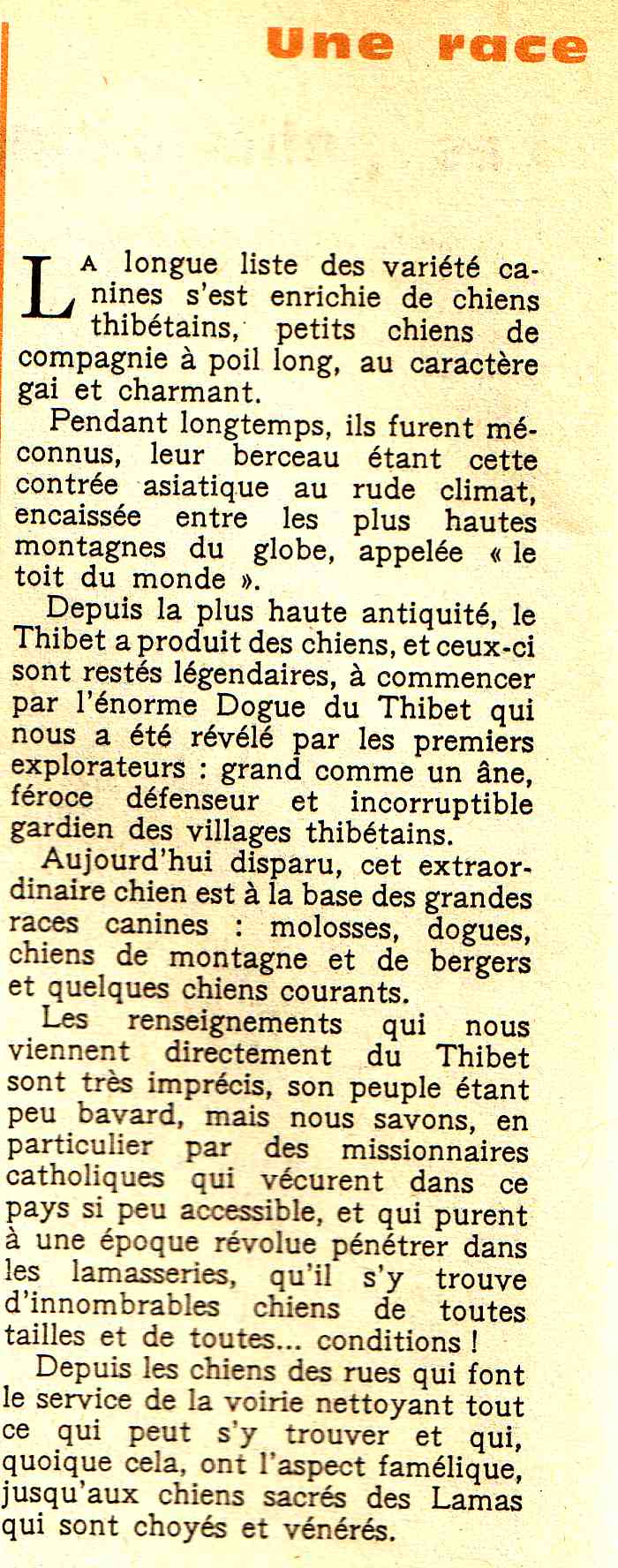
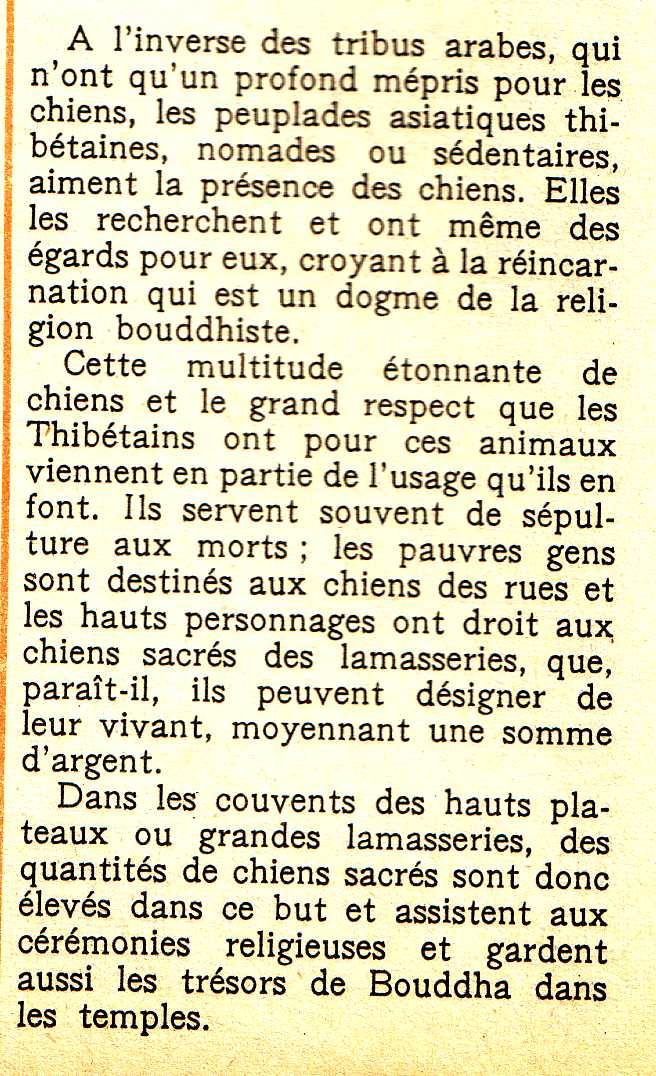 2
2 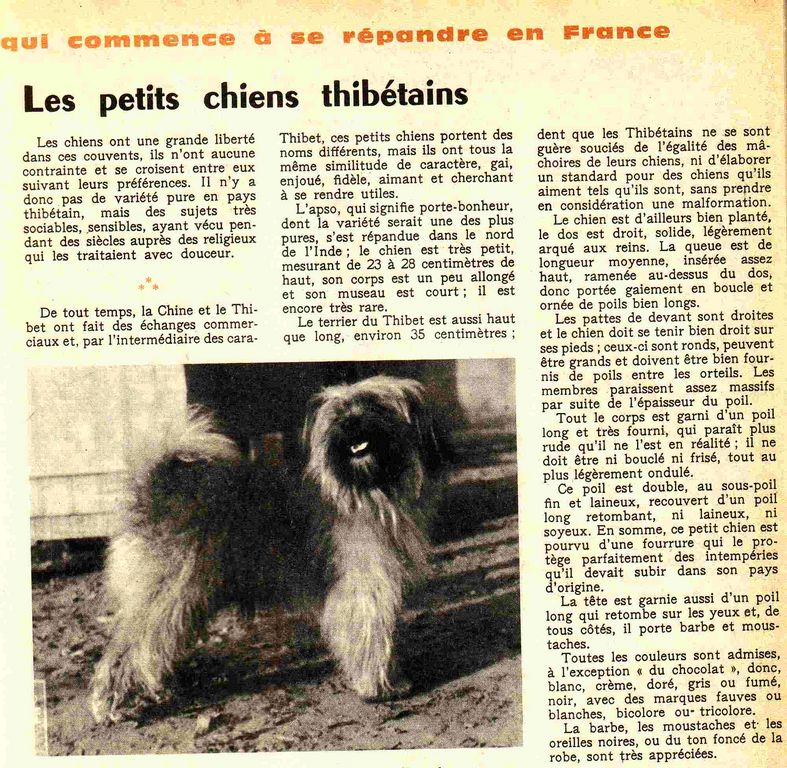 3
3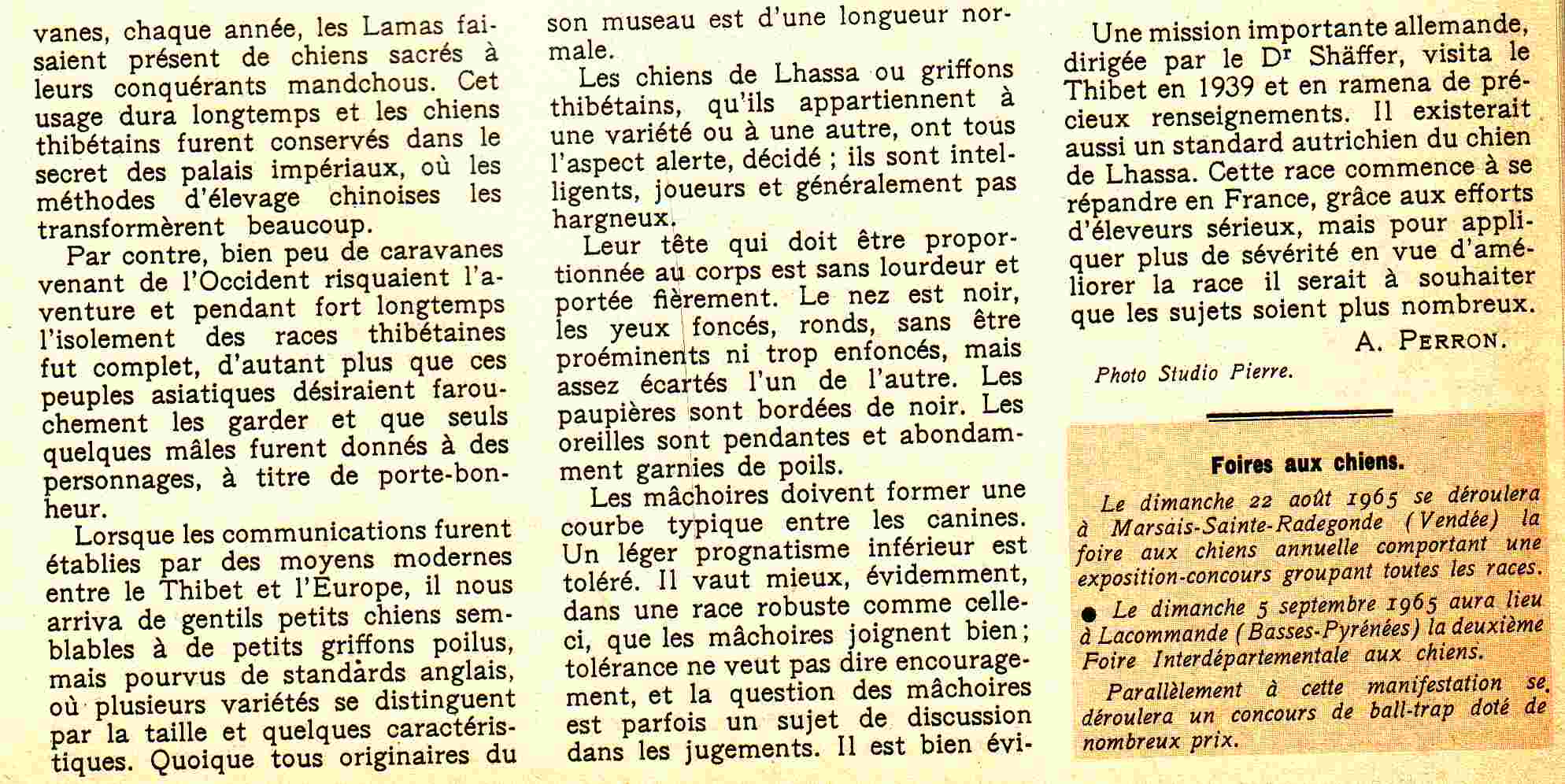 4
4
One Breed Starting to Catch on in France
Merci à Susan Waller Miccio
pour son travail de traduction des articles
Si vous voulez visiter son site
vSa

One Breed Starting to Catch on in France
The Small Tibetan Dogs
This article appeared in Le Chasseur Français (The French Hunter) in 1965.
The long list of varieties of dogs is
enriched by Tibetan dogs, small, long-haired companion dogs with a gay and charming
personality.
For a long time, they were misunderstood,
their cradle being this Asian region with the harsh climate, boxed in amongst
the highest mountains in the world, called “the roof of the world.”
Since great antiquity, Tibet has
produced dogs, and these became legendary, beginning with the enormous Dogue du
Thibet [Tibetan Mastiff] which the first explorers revealed to us: as large as a donkey, ferocious defender and
incorruptible guardian of Tibetan villages.
Now disappeared, this extraordinary dog is
the foundation for all the largest dog breeds: molossers, dogues, mountain dogs
and shepherds, and some coursing dogs.
The information coming to us directly from Tibet is very
imprecise, the people not being very talkative.
However, we know, especially from the Catholic missionaries who lived in
this very inaccessible country and who were able to penetrate the lamaseries in
that bygone era, that there were innumerable dogs of all sizes and all conditions,
which ranged from the starving dogs that did the work of street-cleaners,
cleaning up everything that they found there, to the sacred dogs of the lamas
who were cherished and venerated.
Unlike the Arab tribes, who had only deep contempt
for dogs, the Tibetan peoples, nomadic or sedentary, loved the presence of
dogs. They seek them out and and even
have respect for them, as belief in reincarnation is a tenet of the Buddhist
religion.
This astonishing multitude of dogs and the
great respect that the Tibetans have for these animals comes in part from the
service they perform. They often take part in the burial of the dead; poor
people are destined for the street dogs but wealthy persons have a right to [be
consumed by] the sacred dogs of the lamaseries that they may apparently designate
during their lifetime with a sum of money.
In the monasteries of the high plateaus – or grand
lamaseries – many sacred dogs
are bred for this purpose and assist in religious
ceremonies and also to guard the treasures of Buddha in the temple.
In these monasteries, great freedom is given
to them. They are not confined and are
allowed to cross-breed according to their preferences. Therefore, there isn’t any pure type in Tibet, but very
sociable, sensitive individuals, having lived through the centuries among the
religious who treated them gently.
China has always traded with Tibet and, via Tibetan caravans,
the lamas presented some sacred dogs to their Manchu conquerors. This practice continued for a long time, and
the Tibetan dogs were kept in the secrecy of the imperial palaces where the
Chinese breeding methods changed them significantly.
By contrast, very few caravans from the
West risked the adventure and, over a very long time, the Tibetan breeds were
completely isolated, especially as these Asian peoples fiercely guarded them. Only
some males were gifted to important persons for good luck.
When modern communications were established
between Tibet and Europe, nice little dogs resembling hairy little griffons
came to us, which under the English standards were differentiated into varieties
by size and other characteristics. Since
all originated from Tibet,
these little dogs were called by different names but all were similar in
personality – gay, joyful, loyal, loving, and wanting to be useful.
The apso, a good-luck charm, whose type is
one of the purest, has become widespread in northern India. This dog is very small, measuring 23 to 28
centimeters, his body is a little longer and his muzzle is short. He is still very rare.
The terrier of Tibet is taller than long, about 35
centimeters, his muzzle is of normal length.
The Dogs of Lhasa, or Tibetan griffons,
whether they belong to one variety or to another, all have an alert, determined
expression. They are intelligent,
playful and generally not snappish.
Their head, well-proportioned to the body, is
without heaviness and is carried proudly.
The nose is black, the very dark eyes are round, neither too prominent nor
too deep-set, but set well apart from one another. The eyelids are bordered in black. The drop-ears are well-furnished with hair.
The bite must form a typical curve between the
canines. A slight underbite is
acceptable. Evidently, an even bite is
preferred in a robust breed like this one.
That is not to say that “tolerated” means “encouraged,” and the question
of the bite sometimes is a subject of discussion in judging. It is evident that
Tibetans don’t care enough about even bites to develop a standard for their
dogs that they like as they are – they do not consider an underbite a
deformity.
The dog is also well-set, the back is straight,
firm and slightly arched over the loins.
The medium length tail is set rather high and turns over the back,
carried gaily in a curl and adorned with long hair.
The front legs are straight, and the dog should stand well forward on his feet. These [paws] are rounded, can be large and
must be well-furnished with hair between the toes. He must stand on his pads, not on the nails. The limbs appears
to be quite solid due to the thickness of the hair.
The entire body is well-covered with ample coat,
which seems coarser to the touch than it actually is. It must not be curly or frizzy but slightly
wavey.
The coat is double; the undercoat is fine and
woolly covered by an outer coat of long, falling hair that is neither soft nor
woolly. In sum, this little dog is provided with a coat that weatherproofs him
perfectly in his country of origin.
The head is also adorned with long hair that falls
over the eyes and on both sides, and he has a mustache and beard.
All colors are acceptable with the exception of
“chocolate”: therefore, white, cream, golden, gray or smokey, black with tan or
white markings, particolor or tricolor.
Black or dark-colored beard and ears are very appreciated.
An important German mission, under the direction of
Dr. Shaffer, visited Tibet
in 1939 and brought back valuable information.
There would be an Austrian standard for the dog of Lhasa.
This breed begins to become more widespread in France, thanks
to the efforts of serious breeders. To more rigorously improve the breed, however, we
must hope for greater numbers of dogs.
A. Perron
 CHASSEUR FRANCAIS 1967
CHASSEUR FRANCAIS 1967
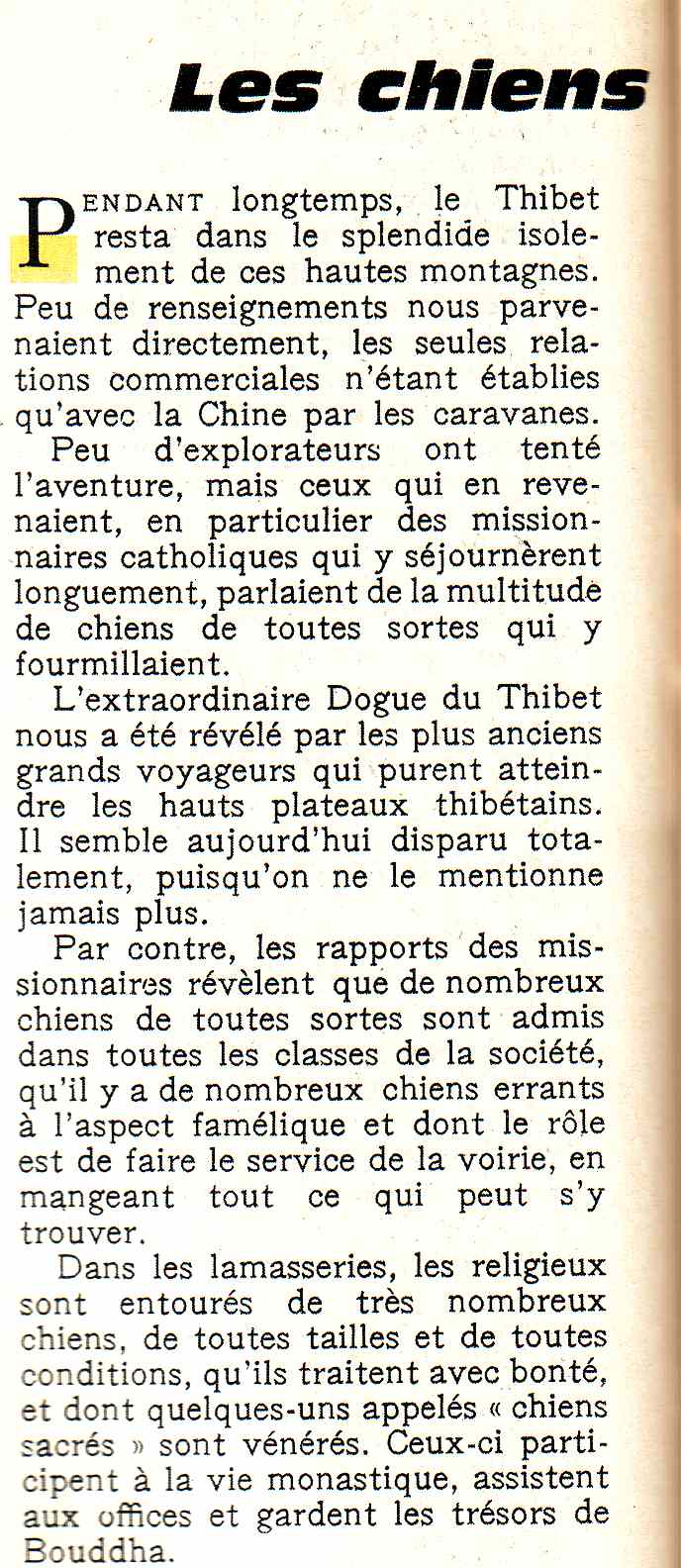
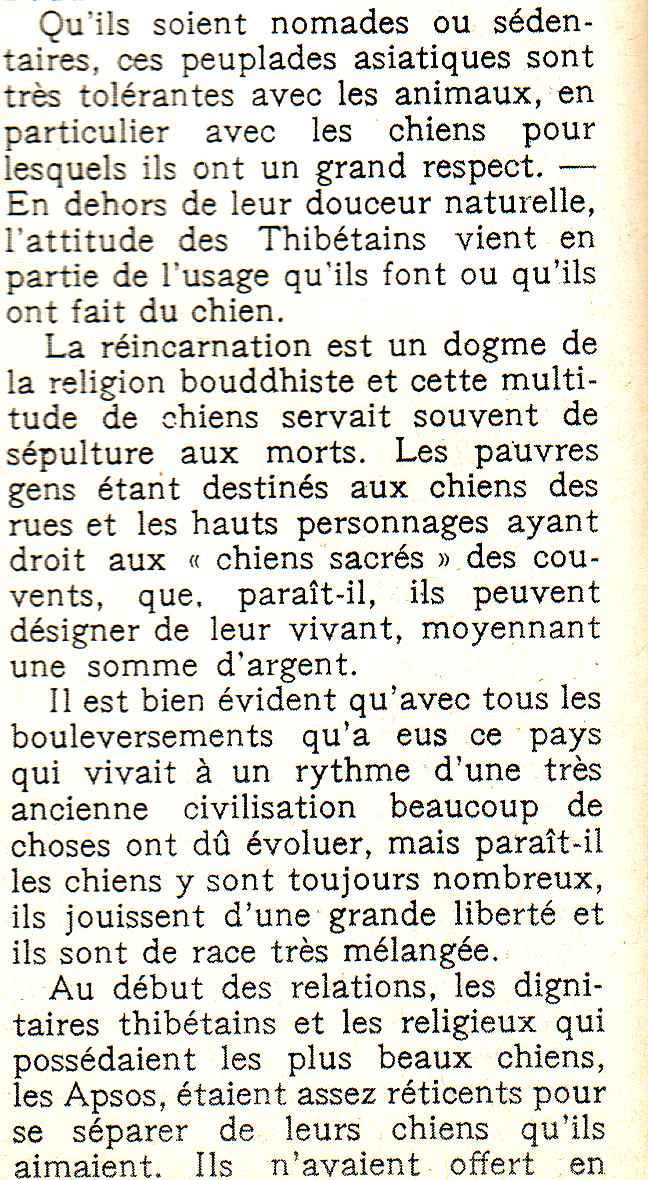
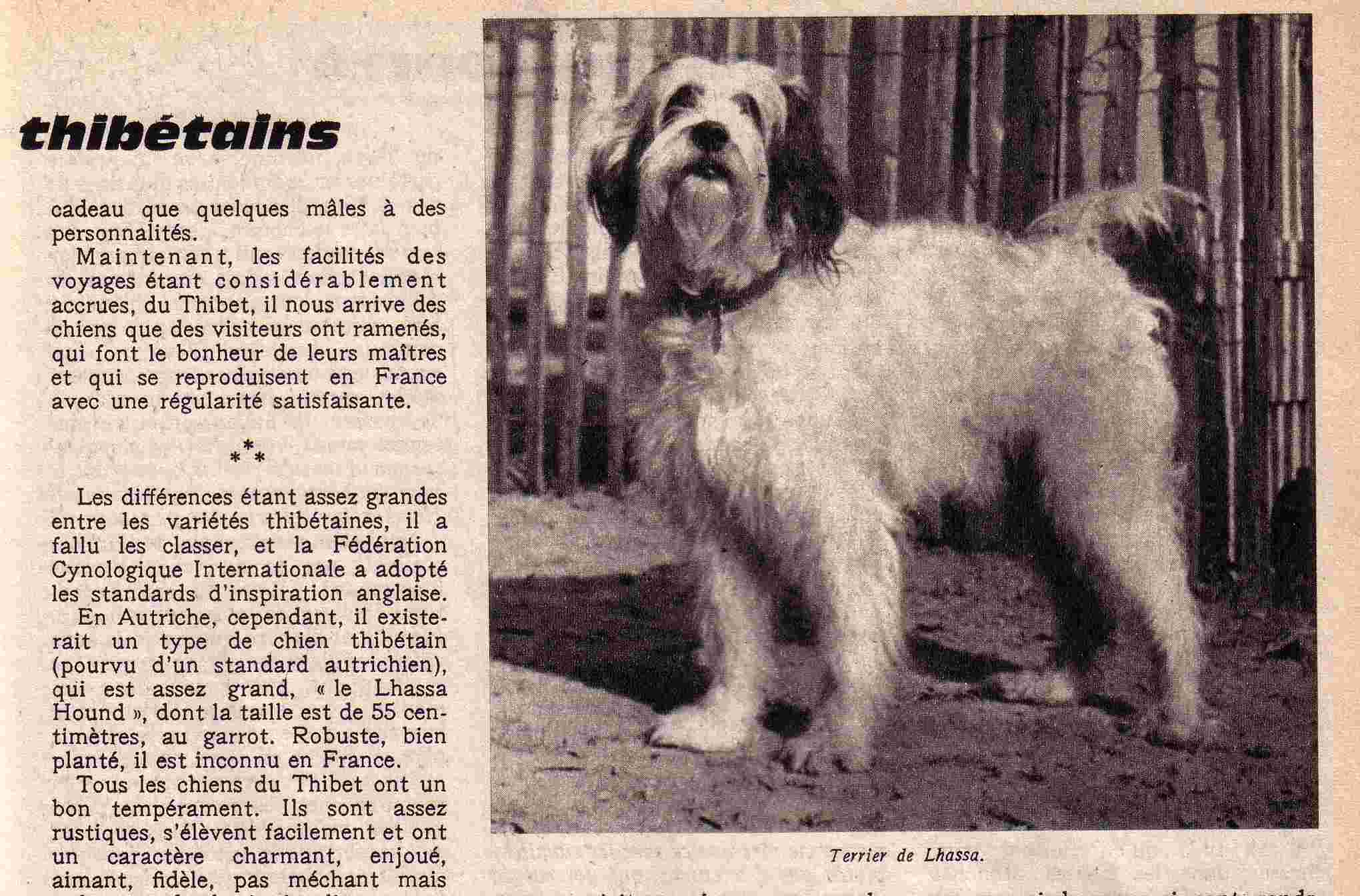
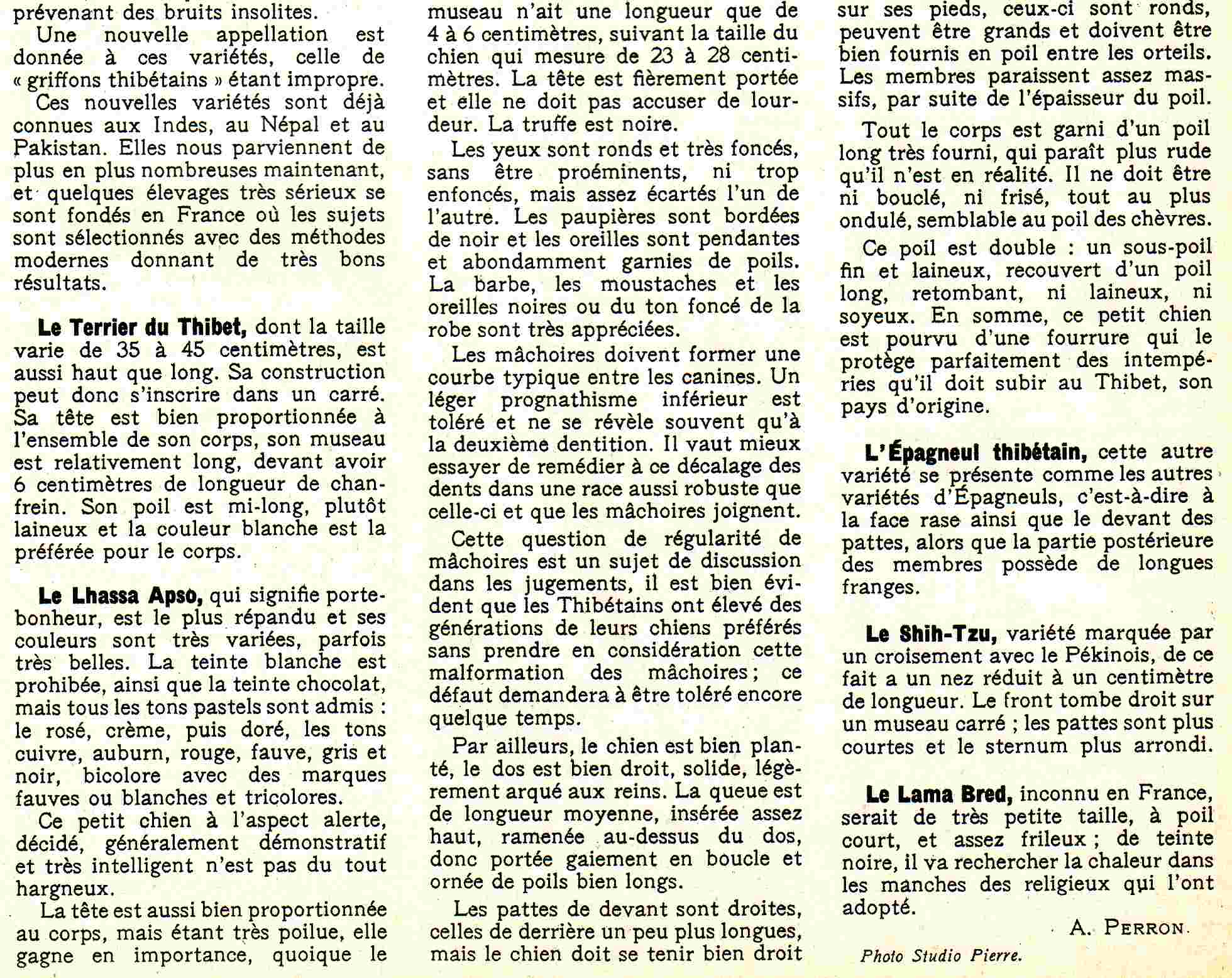 Merci à Susan Waller Miccio
Merci à Susan Waller Miccio
pour son travail de traduction des articles
Si vous voulez visiter son site
vSac

The Tibetan Dogs
This article appeared in Le Chasseur Français (The French Hunter) in 1967.
For a long time, Tibet remained in splendid
isolation among high mountains. Little
information came to us directly. The only commercial trade relations established
were by caravan with China.
Few explorers have tried it, but those who
came back, especially the Catholic missionaries who stayed there for a long
time, spoke of the multitude of dogs of all kinds that swarmed there.
The extraordinary Dogue du Thibet [Tibetan
Mastiff] was revealed to us by travelers who were able to reach the high
Tibetan plateau in antiquity. The breed
now seems to have now disappeared completely since no one ever mentions it any
longer.
By contrast, the reports of the missionaries
reveal that many dogs of all types are allowed among all classes of society,
and that there are many hungry-looking stray dogs, whose role is to clean the
streets, eating everything they find there.
In the lamaseries, the monks are surrounded
by many dogs of all sizes and shapes, which the monks treat with kindness and
which some called “sacred dogs” are revered.
These [sacred dogs] take part in the monastic life, attend services and
guard the Buddhist treasures.
Whether nomadic or sedentary, these Asiatic
peoples are very tolerant with animals, in particular with the dogs for which
they have great respect. Besides their natural sweetness, the attitude of the
Tibetans comes in part from the use they make of the dogs or
the use dogs make of them.
Reincarnation is a tenet of the Buddhist
faith and this multitude of dogs often serves in the burial of the dead. Poor
people are destined for the street dogs and more important personages have a right
to the “sacred dogs” of the monasteries that, it seems, they can designate
during their lifetime for a sum of money.
With all its upheavals, it is obvious that many things had to evolve in a country that lives at the pace of a very
ancient civilization. However, it seems
that dogs were always numerous there, that they enjoy great freedom and that they are of a very mixed
breeding.
At the start [of international] relations, Tibetan
dignitaries and monks who possessed the most beautiful dogs, the Apsos, were
very reluctant to part with the dogs they liked. They offered only some males as gifts to important
people.
Now, with travel to Tibet being considerably easier,
travelers have brought back some dogs.
These dogs have brought their masters good luck and have reproduced in France with
satisfying regularity.
The differences between the varieties of Tibetan
dogs being fairly significant, it became necessary to classify them and the
Federation Cynologique International (FCI) adopted standards inspired by the
English standards.
In Austria,
however, there was a type of Tibetan dog (provided with an Austrian standard),
which is fairly large, “the Lhasa
Hound,” 55 centimeters (21 – 22 inches) tall at the withers. Robust and well-built, he is unknown in France.
All the Tibetan dogs have good temperaments. They are quite hardy, breed easily and have
charming personalities – playful, loving, loyal – not bad but attentive to
unusual noises.
New names were given to these types, the “Tibetan
Griffon” being inappropriate. Already known in India,
Nepal and Pakistan, these
new varieties now reach us in greater and greater numbers. Some very serious breeders have been
established in France
where the dogs are being selected [for breeding] with modern methods and have yielded
very good results.
The Tibetan
Terrier, whose height varies from 35 to 45 centimeters [14
to 18 inches] is as tall as long. His
build is therefore like a square. The head is well-proportioned to the body and
the muzzle is relatively long, being six centimeters [2.5 inches] in length to
the nose. His coat is of middle length, rather woolley, with white being the
preferred color for the body.
The Lhasa Apso, which means good luck charm, is the most widespread. Their colors are very varied and sometimes
very beautiful. The color white is
prohibited as is chocolate color, but all the soft shades are accepted: pink, cream, golden, copper tones, auburn,
red, tan, gray and black, particolor with tan or white markings and
tricolors. This little dog has an alert,
determined expression, is generally expressive and very intelligent but not at
all snappish. The head is also
well-proportioned to the body but, being very hairy, it seems larger even though
the muzzle is only 4 – 6 centimeters [1.5 to 2.4 inches] long depending on the
size of the dog, which measures between 23 to 28 centimeters [9 to 11
inches]. The head is carried proudly and
must not have any heaviness. The nose is
black. The very dark eyes are round,
neither too prominent nor too deep-set, but set well apart from one
another. The eyelids are bordered in
black. The drop-ears are well-furnished
with hair. Black or dark-colored beard, mustaches and ears are very
appreciated. The bite must form a typical curve between the canines. A slight underbite is acceptable and often
doesn’t develop until the permanent teeth erupt. It is preferable to try to correct offset
teeth in a breed as sturdy as this one so that the bite aligns well [is even]. This question of the regularity of the bite
is a subject of discussion in judging. The Tibetans have obviously bred
generations of their preferred dogs without giving any consideration to this
malformation of the jaws, so this fault will have to be tolerated [accepted] for some time to come. Otherwise,
the dog is well-set, the back is straight, firm and slightly arched over the
loins. The medium length tail is set
rather high and turns over the back, carried gaily in a curl and adorned with
long hair. The front legs are straight, the hind legs a little longer, but the dog should stand well
forward on his feet. These [paws] are
rounded, can be large and must be well-furnished with hair between the
toes. The limbs appear to be quite solid due to the thickness of
the hair. The entire body is
well-covered with ample coat, which seems coarser to the touch than it actually is. It must
not be curly or frizzy but slightly wavey, similar to the coat of goats. The coat is double; the undercoat is fine
and woolly covered by an outer coat of long, falling hair that is neither soft
nor woolly. In sum, this little dog is provided with a coat that weatherproofs
him perfectly in his country of origin.
The Tibetan
Spaniel, has the appearance of other kinds of spaniels,
that is to say that the face is clear as is the front of the legs while the
back of the limbs have long fringes.
The Shih-Tzu, has a nose reduced by a centimeter of length as a result of crossing with
the Pekingese. The forehead falls
straight onto the square muzzle; the legs are shorter and the chest more
rounded.
The Lama Bred, unknown in France,
would be of very small size, short-haired and quite sensitive to cold.
Black-colored, he seeks warmth in the arms of the monks who have adopted him.
Perron A.
Perron.

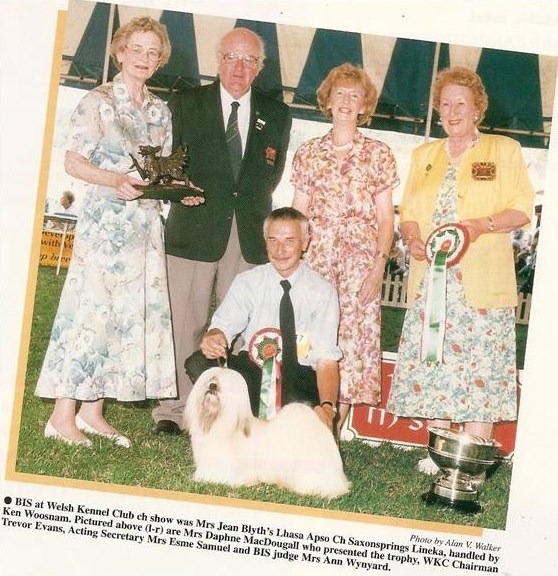
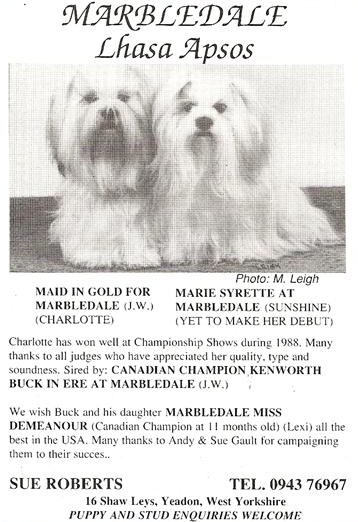
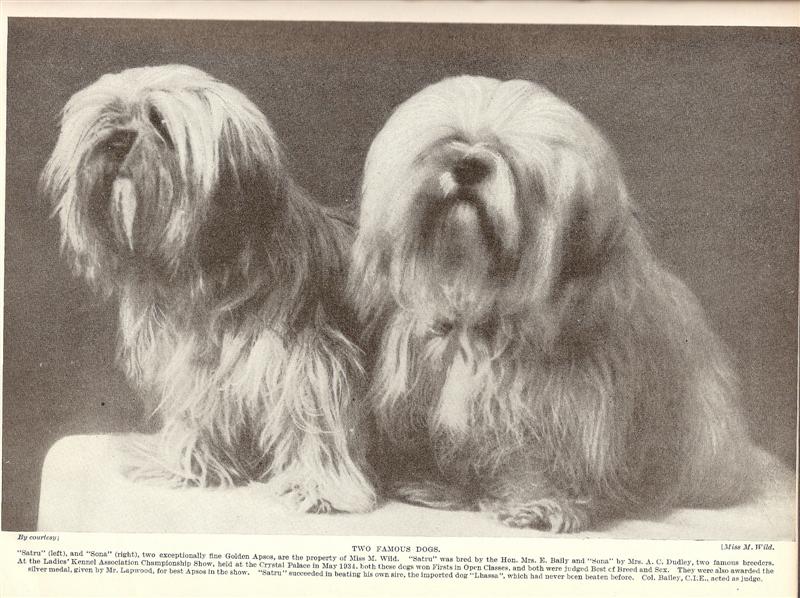


















 2
2  3
3 4
4













